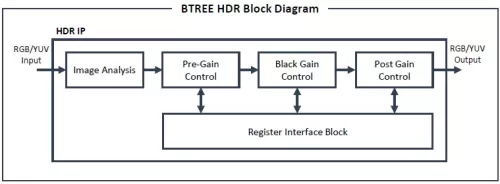HDR improves the visibility of the output image compared to the input images by increasing the contrast of the image/video reproduced on the display. BTREE's HDR algorithm automatically analyzes the input image/video and calculates the brightness value for each region. User can control the strength of the HDR output and select the region to apply the HDR.
High Dynamic Range
Overview
Key Features
- Configurable Maximum Display Resolution :
- FHD/QHD
- 2 BUS / 4 BUS of Interface
- 10 bit of Bit Processing
- ROI Support :
- Region of Interest
- Automatic Generation of HDR Gain Curve
- Increased Visibility due to Increased Dynamic Range on Screen
Benefits
- Low H/W Cost
- 10 bit Single Frame HDR
- Easy to Tune
- Power Saving
Block Diagram

Video
BTREE HDR IP (DDI IP)
HDR improves the visibility of the output image compared to the input images by increasing the contrast of the image/video reproduced on the display. BTREE’s HDR algorithm automatically analyzes the input image/video and calculates the brightness value for each region. Users can control the strength of the HDR output and select the region to apply the HDR.
Deliverables
- IP Specification
- Encrypted RTL Source Code IP Core
- Comprehensive Integration Guide
- Technical Support and Maintenance Updates
Technical Specifications
Short description
High Dynamic Range
Vendor
Vendor Name
Related IPs
- Audio ADC with 100 dB Dynamic Range, 24-bit six channel with embedded VAD
- Audio CODEC with 100 dB Dynamic Range, 24-bit stereo PWM DAC, six-channel ADC
- Audio codec with capacitor-less 106 dB dynamic range ADC and 100 dB DAC with very low latency filters
- Audio codec with capacitor-less 104 dB dynamic range ADC and 100 dB DAC
- Audio codec with capacitor-less 101 dB dynamic range ADC and 115 dB SNR DAC with very low latency filters
- Audio codec with capacitor-less 106 dB dynamic range ADC and 120 dB SNR DAC with low latency